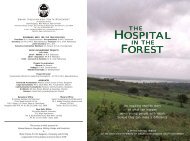Janaagraha - Resource Communications Pvt. Ltd
Janaagraha - Resource Communications Pvt. Ltd
Janaagraha - Resource Communications Pvt. Ltd
You also want an ePaper? Increase the reach of your titles
YUMPU automatically turns print PDFs into web optimized ePapers that Google loves.
J A N A AG R A H A C E N T R E F O R C I T I Z E N S H I P A N D D E M O C A R C Y<br />
C O R E P R O G R A M M E S<br />
20 21<br />
3. Co-ordination mechanisms on all Municipal Services as per Schedule XII<br />
(and Schedule XI) of the Amendment to the Constitution of India<br />
a. Alignment of Jurisdictions based on ward boundaries<br />
b. Joint budgeting/reporting cycles<br />
4. Establishment of Spatial Data Centre<br />
a. Real-time GIS for planning and coordination across agencies<br />
5. Establishment of a regional Integrated Transport Authority<br />
a. Planning and coordination across all public transport agencies<br />
6. Implementing muncipal reforms at city-level<br />
a. Financial Reforms in Budgeting, Accounting, MIS<br />
b. HR and capacity building<br />
c. Building codes<br />
7. Urban land reforms<br />
a. Simplified land records management<br />
b. Guaranteed land title system<br />
8. Integrated services for the urban poor<br />
a. Provision of low-income housing<br />
b. Other urban poor programmes such as micro-finance, skills upgradation, etc.<br />
9. Defining and ensuring service outcomes<br />
a. Establishing qualitative and quantitative benchmarks<br />
b. Management and monitoring processes<br />
c. Equitable outcomes for the poor<br />
10. Development and delivery of comprehensive city plans<br />
a. Regional footprint<br />
b. Involvement of multiple stakeholders<br />
c. Creation of appropriate infrastructure<br />
d. Rigorous enforcement—e.g. zoning/land-use<br />
e. Regular mapping/monitoring of economic activities in the city<br />
11. Sustainable Urban Environment and Ecology<br />
a. Using EIAs (Environmental Impact Assessment) to assess impact of urban<br />
growth on the environment<br />
b. Sustaining natural resources using appropriate technologies<br />
c. Formulation of appropriate policies of incentives and dis-incentives to protect<br />
the environment and ecology and to curb consumption<br />
12. Sustaining the Urban Economy<br />
a. Nurture the city’s natural competitive advantages such as natural resources,<br />
land, human resources and build on requirements of infrastructure,<br />
sustainability of resources, equitable public investments<br />
b. Regular analysis of regional and local economic activity in both formal and<br />
informal economies. Employment forecasting and the impact of migratory<br />
trends<br />
c. Formulation of plans with flexibility to capture new economic opportunities<br />
and policies to encourage the informal sector to develop into formal sector<br />
businesses<br />
d. Formulation of responsible public-private partnerships while developing<br />
economic strategies<br />
This is an evolving framework that we will continue to enrich.<br />
The figure below shows the regional framework for planning and coordination<br />
R E GI O N AL<br />
S P A T I AL D A T A<br />
CE N T R E<br />
CO N CE R N E D LO CAL GO V E R N M E N T S<br />
R U R A L<br />
T AL UK / ZI L L A<br />
P ANC H A Y A T S<br />
GR AM A<br />
P ANC H A Y A T S<br />
GR AM A / W AR D<br />
S AB H A S<br />
U R B A N<br />
UR B AN LO CAL<br />
GO V E R N M E N T<br />
W AR D<br />
CO M M I T T E E S<br />
AR E A S AB H A S<br />
1 M E T R O P O L I T AN P L ANN I N G CO M M I T T E E 10<br />
M E T R O P O L I T AN<br />
4 T R ANS P O R T 5<br />
AU T H O R I T Y<br />
CO N CE R N E D P AR A- S T A T AL S , S P E CI AL - P UR P O S E V E H I CL E S ,<br />
S T A T E GO V T. D E P AR T M E N T S<br />
L AW & O R D E R<br />
P O W E R D I S T R I B UTI O N 9 R E V E N UE<br />
7<br />
P UBL I C H E ALT H<br />
P L ANN I N G & ZO N I N G<br />
E CO N O M I CS &<br />
S T A T I S T I CS<br />
E N V I R O N M E N T &<br />
F O R E S T RY<br />
<strong>Janaagraha</strong>’s learning about successful advocacy is that it requires debate, agreement on<br />
principles, defining specific outcomes, forming coalitions, and most importantly,<br />
relentless leadership to effect change.<br />
2<br />
6<br />
2<br />
3<br />
E D UC A T I O N<br />
I N D US T R I AL<br />
D E V E LO P M E N T<br />
W O M E N &<br />
CH I L D W E L FA R E<br />
W A T E R &<br />
S ANI T A T I O N<br />
UR B AN P O O R<br />
S E R V I CE S<br />
9<br />
8<br />
AL L P UBL I C<br />
T R ANS P O R T<br />
AGE N CI E S<br />
( B US / R AI L / AI R /<br />
T AXI S / AU T O<br />
/ R T O e t c . , )<br />
AL L R E L E V ANT<br />
R E GU L A T O RY<br />
AU T H O R I T I E S<br />
3<br />
9















